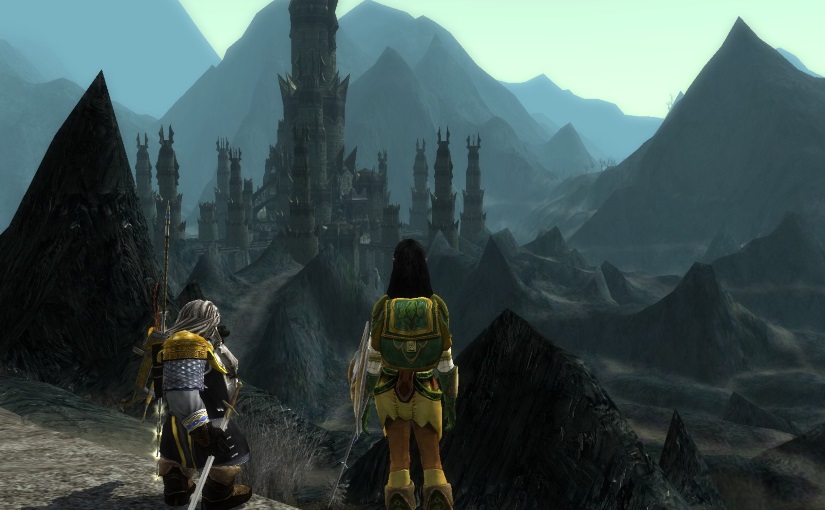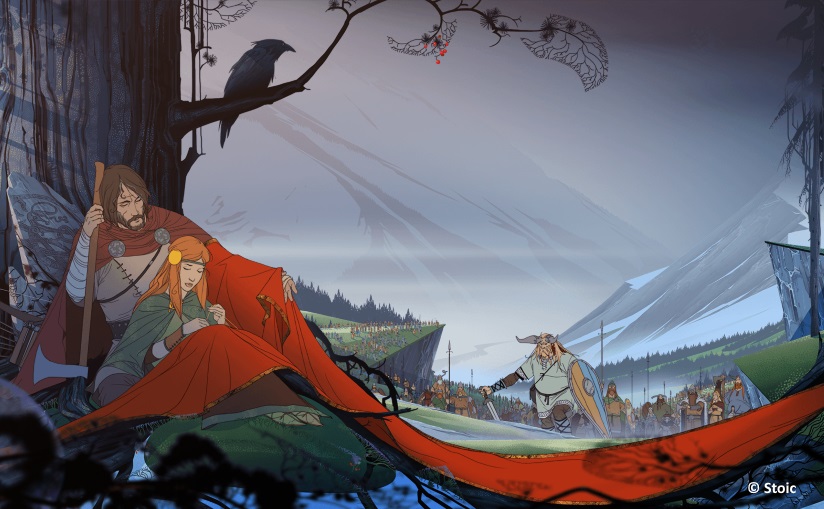Design your own difficulty – how LOTRO lost its soul
I’ve wondered for a while what the use of analytics in driving game design would mean for games. There are clearly massive benefits. But along the way I think there are casualties, particularly when it comes to the uniqueness of a vision a designer has for the experience they’ve created. The only time I’ve articulated it was in relation to LOTRO, on their forum a while back. I’ve edited that commentary below:
I spent a lot of time in Turbine’s version of Middle-Earth, The Lord of the Rings Online (LOTRO), from the beginning onwards. But, around the time the Enedwaith expansion landed, I found myself less and less engaged with the game. I couldn’t articulate my concerns for a long time, until the developers released the Fornost Dev diary, outlining their re-imagining of the defining quest cluster for characters around the level 30-40 mark, via the grouping mechanic, the Instance Finder.
LOTRO has gained a streamlined levelling experience in recent years, attuned I believe to the raft of analytics it would have employed when it decided to go from the subs model to a free to play (F2P) model. I think that designing the experiences based around optimising player engagement in the world, from the point of view of getting them to spend money in the LOTRO store, killed interesting aspects of the game’s character, perhaps even its soul.
Which all sounds a bit melodramatic but really only reveals an old player’s appreciation of this huge game’s foibles, nuances and quirks that became indelibly linked to its charm.
Take Fornost. It was, first time around, a big old sprawling, rather challenging citadel. Progress through it (mazy and oftentimes confusing) was gated, like Carn Dum and Helegrod were before they underwent the same ‘instance-izing’ process to break up those quest spaces into bite-sized chunks. All these instances are now more friendly to the casual/time-poor player but also reworked to pack in lots more deeds and titles to grind for the less time-poor (for the uninitiated, think XBOX achievements that reward you with a pittance of ingame currency to use in the store).
As with Helegrod, the Rift (another main raid instance) and Carn Dum in their original splendour, you used to have to get through Fornost; you planned ahead to commit an evening, got on voicechat with a group and you needed a good few hours to complete it, culminating in a battle against an undead champion high in a tower at Fornost’s heart. Experienced in this way, when you finished Fornost you broke Fornost. Entirely. You dealt a major blow to Sauron’s power that was creeping south of Angmar. It was simply a larger scale of questing and interaction with Middle-Earth’s unfolding War of the Ring than those more minor quests helping Farmer Giles with his shrews.
Pretty much the last time I quested with my kin (guild), we had just taken on a new member and he was doing his ‘legendary items’ quests (the endgame of the first release of the game). Only the skill rewards are needed these days, the once amazing magic item rewards can be bought off a shopkeeper now!
So we went into Carn Dum. He had played some World of Warcraft (WOW) so was familiar with its instances. He was staggered at the scale of it, a mere 6 man instance. It was indeed vast, it was ‘uneconomical’ in analytics terms, but by the time this guy got there with us, many expansions later, you could now avoid huge swathes of its layout ; the unoptimised and imbalanced sequence of action beats culminating in that once rock-hard fight against the Witch-King could be sidestepped by a simple bridge straight to the heart of the fortress. I found myself imploring him to find an on level group to run through it in all its glory before it was too late and he levelled past it.
It’s clear from the ‘lair’ instances that followed, such as the Watcher raid and Draigoch, that the sense of scale has much diminished in terms of quest design. Barad-Guldur wasn’t even instanced in its entirety like Carn Dum or Urugarth; you can run through it, past six or seven orcs milling about, right to the tower where its raid resides. The rest of it is broken up into optional…that’s right…bite-sized skirmish instances. Sorry, but what kind of stronghold is that?
But of course, we can now all enjoy Fornost and the other major and minor instances, at almost any level, with customisable group sizes, customisable levels of challenge and concomitantly adjusted levels of reward, all refreshed with new deeds and bosses and items.
The game has in many ways been made new, due to the Instance Finder, no doubt refined by the analytics that illustrated what would encourage statistically the most engagement, with both the content of the game and the shop where they now make their money.
This means, however, you no longer ‘break’ Fornost, in the same way you no longer ‘break’ Helegrod. You do self-contained sections, in whatever order you choose. You can retire from the fight not really having connected or engaged with the bigger picture of either citadel in the fiction the designers originally wove around Tolkien’s work, often brilliantly so.
Thorog (the undead dragon once at the end of the Helegrod raid instance) has almost become a fast food, not the end goal of one or more evening’s runs through what are, these days, effectively instanced boss lairs, sub-hour chunks. You don’t even have to travel to these locations anymore. You can accept a group request via the Instance Finder while sat in the Prancing Pony, be whisked off across the lands and be dropped back to your exact seat with your half finished meal still on the table an hour later.
The shape of the world the devs built from the first release to the present day is also a journey those devs made in terms of game design and layout. Along the way they made mistakes, and I’m not against the fixing of many mistakes that were just plain annoying, or bugs.
But some of these instances, the Rift raid for my kin in particular, had a character that through our engagement with them forged treasured memories that these metrics driven re-imaginings kill. It isn’t that it was harder before, because now we have ‘Challenge Mode’. Now all group content is falling into a single (multi tiered) format designed to maximise the grinding of deeds, but in more casual and now solo-friendly versions. The game was once gloriously uneven, with areas that provoke ‘misty eyed’ reminiscings of the tackling of their infuriating difficulty or strange progression, areas that were objectively these things. The few of these moments that remain coalesce into the last bastions of the game LOTRO was, such as the on level deed to visit all the towers of Barad Gularan or the Dark Delvings instance; areas with a character all their own, even amongst their peers, areas that you could actually feel something unique about, because you couldn’t design their difficulty.
Measuring ourselves up to the challenge of killing a Balrog, my kin had a means of seeing itself improve in terms of teamwork. We had something to aim for, and that something was exactly the same thing as every other kin had to aim for.
I’m sure it isn’t good for the game’s longevity (profits) that it goes back to what it was, but this post records only what is lost.
Now I can make my game as easy or hard as I want, with as many or as few players as I choose. For the final few months I logged in I felt like a tourist rather than a hero. It seems Middle-Earth’s challenges are really not its own anymore, but those of my own making.
I’m sure Frodo would have wished he had such luxury approaching Shelob’s Lair.






